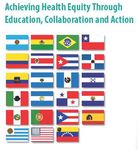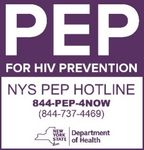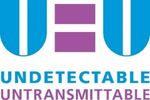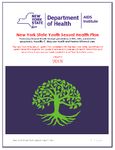Introduction: successes and challenges - New York State ...
←
→
Page content transcription
If your browser does not render page correctly, please read the page content below
In addition to reducing new infections, care outcomes
for people living with diagnosed HIV are improving. In
addition to HIV incidences and diagnoses falling to
record lows, the new 2019 data shows 83 percent of
newly diagnosed New Yorkers were connected with care
The AIDS Institute is committed to eliminating new within 30 days of being diagnosed, and viral suppression
infections, improving the health and well‐being of among people in care was at 89 percent at the end
persons living with HIV, sexually transmitted infections of 2019.
(STIs), and viral hepatitis, and improving LGBTQ and drug
user health. This mission can be concisely stated as "End Syringe Exchange Programs (SEPs) in NYS served more
epidemics, fight stigma, promote health." The purpose than 28,800 people in 2020, including more than 8,818
of this document is to discuss the actions the AIDS new enrollees, and exchanged almost 11.8 million
Institute is taking in partnership with stakeholders to syringes. There are currently more than 800 registered
bring this mission to life. Opioid Overdose Prevention Programs throughout the
State. Since the program began, more than 625,000
individuals have been trained as overdose responders. Of
Introduction: successes and challenges these, approximately 83,000 were public safety
New York State (NYS) has long been considered the personnel and the rest were community responders. In
epicenter of the HIV epidemic in the U.S., as well as a addition, 1,773 people were active participants in the
visionary force for responding to the epidemic and the Drug User Health Hub (DUHH/hub) programs.
underlying causes which perpetuate it. Innovative
strategies have been developed through the collective In 2018, Governor Cuomo announced the nation’s first
effort of NYS’s consumers, community‐based strategy to eliminate hepatitis C (HCV). The elimination
organizations, public health entities, health care effort aims to stop the spread of the virus by expanding
providers, and advocates. Governor Cuomo’s “Ending programs to connect New Yorkers with prevention,
the Epidemic” (ETE) initiative is an example of New screening, and treatment services, as well as enhancing
York’s leadership in the provision of HIV care and HCV surveillance. The AIDS Institute has initiated an array
prevention and support services. In 2019, estimated HIV of statewide HCV prevention and care programs,
incidence fell below HIV mortality for the first time, including rapid testing, HCV care and treatment, the
resulting in the first ever decrease in HIV prevalence in expansion of the Criminal Justice Initiative to include
NYS. While we have achieved this critical milestone, the services for persons with HCV, and HCV Patient
focus for 2020 and beyond will be to continue to address Navigation Programs within Drug User Health Hubs.
disparities to ensure these gains are realized equitably
by all populations. Still, challenges remain. Approximately 23% of persons
living with diagnosed HIV have not reached the goal of
viral suppression. Viral suppression eliminates the risk of
sexual transmission and leads to better health outcomes.
In 2019 almost 20% of persons newly diagnosed with HIV
were also diagnosed with AIDS. In 2019, more than
172,000 sexually transmitted infections (STI) diagnoses
were reported statewide, more than any other
reportable communicable disease. In the past five years,
syphilis rates have more than tripled among females and
increased by approximately 40% among males. While
maternal transmission of HIV has been nearly eliminated
This bold initiative is making its impact. The number of in NYS, cases of congenital syphilis have been increasing
people newly diagnosed with HIV in NYS has fallen to since 2015. In NYS there are an estimated 116,000 people
historic lows. At its peak in the mid‐1990s, New York living with HCV, and many of them are unaware they are
diagnosed nearly 15,000 new cases per year; that
infected. The impact of the opioid epidemic continues to
number is down to 2,377. Since 2014, when ETE was
be felt in communities throughout NYS and the country.
announced, new diagnoses are down 20 percent. The
decreases have been observed in almost every large Across all areas of the AIDS Institute mission, health
demographic group. disparities persist among communities of color, LGBTQ
persons, persons who are criminal justice involved, and
Thanks to the State's extensive work with providers and
other stakeholders to raise awareness of available people who use drugs.
medication to prevent transmission of HIV safely and
effectively, new data also shows nearly 40,000 New
Yorkers took pre‐exposure prophylaxis (PrEP) in 2019 —
an increase of almost 25 percent from 2018.
1of Care Program, Clinical Guidelines, and Clinical
New York Action Education Initiative (CEI).
Priority 1: Improve HIV care outcomes, including timely
HIV detection and higher rates of viral suppression.
Action: Continue to promote and support same‐day Priority 2: Increase access to PrEP and Post Exposure
initiation of HIV treatment. Prophylaxis (PEP).
Action: Implement rapid treatment programs for Action: Implement a comprehensive, statewide strategic
persons re‐entering care. plan for PrEP and PEP.
Action: Increase HIV status awareness through testing, Action: Increase awareness of PrEP through a consumer‐
including promoting and expanding access to HIV self‐ informed marketing plan utilizing diverse platforms,
testing. including social media.
Action: Expand efforts to facilitate linkage and retention Action: Incorporate a health equity approach to increase
in HIV care. Institute quality of care methods to identify access and acceptance of PrEP among all communities.
and remove barriers to care. Action: Inform consumers of PrEP payment and cost‐
Action: Increase the number of providers who promote reduction options.
and monitor VLS with their clients to maximize health
Action: Increase immediate access to PEP through NYS
outcomes.
PEP Hotline (rest of state).
Action: Expand/maintain efforts to prevent mother‐to‐
Action: Increase awareness of and access to PEP through
child transmission of HIV; sustain retention in HIV care
consumer materials, guidelines, clinical provider
and viral load suppression throughout and after
education, and the CEI line for clinical providers.
pregnancy.
Action: Integrate HIV care, prevention, and surveillance
PrEP is the use of anti‐HIV medications to keep HIV‐
activities to support linkage and retention in care.
negative people from becoming infected. PrEP for HIV
Action: Match HIV surveillance to other data systems,
prevention is a key cornerstone in the attainment of
including Medicaid, the AIDS Institute Reporting System
complete sexual health, alongside condoms, access to
(AIRS), the Statewide Planning and Research Cooperative
family planning and STI testing. Successful statewide
System (SPARCS), HCV, and STI surveillance, to uncover
implementation of PrEP is attainable with expanded
missed opportunities for earlier diagnosis among
education, awareness, and collaboration among clinical
persons whose HIV infections have gone undiagnosed
providers, HIV testing programs, primary prevention
until they have already progressed to AIDS. Use the
programs, and support services providers. Routinely
results of this work to inform programming aimed at
offering PrEP to anyone presenting with STI‐related
reducing disparities related to HIV testing.
concerns is one way to bring comprehensive sexual
Action: Monitor key performance indicators and
health services to scale in NYS.
milestones to track the HIV epidemic.
PEP following a non‐occupational exposure offers a
A key approach to preventing HIV is to diagnose people
proven means of preventing HIV transmission after
newly infected as quickly and effectively as possible and
potential exposure has already occurred. Treatment for
immediately initiate antiretroviral therapy. An estimated
an exposure should be treated as a medical emergency.
80% of new HIV infections in the United States are
It is key that all emergency departments in NYS have a
transmitted by people who either do not know they have
PEP policy and procedure which includes having ARV
HIV or who have untreated HIV according to the U.S.
medications available onsite. NYS has implemented a
Centers for Disease Control and Prevention. Today,
PEP hotline for all counties outside of New York City.
thousands of New Yorkers are not aware that they are
Consumers may call 844‐PEP‐4NOW for evaluation and
living with HIV and are, therefore, unable to derive the
immediate access to PEP. For consumers in NYC, the
personal and public health benefits of HIV care. Early
hotline number is 844‐3‐PEPNYC. Health care service
initiation of antiretroviral medication dramatically
providers should be aware that a person who seeks PEP
improves the health of people living with diagnosed HIV,
should be given information on risk reduction measures,
including stopping disease progression from HIV to AIDS,
including PrEP.
and directly supports the “Undetectable equals
Untransmittable” (U=U) message that individuals with a
sustained undetectable viral load cannot sexually
transmit HIV.
Best practice standards of care for newly diagnosed
persons and early initiation of antiretroviral medication
are defined and supported by New York State’s Quality
2community groups) to address social determinants of
health, such as poverty, education, employment, and
access to insurance coverage.
Action: Promote services that are responsive to the lived
experiences, trauma, and stigma that disproportionately
Priority 3: Continue coordinated effort to reduce new affect Black, Indigenous, and persons of color.
HIV and STI diagnoses in sexual minorities, including Action: Assist AIDS Institute‐funded organizations to
but not limited to LGBTQ populations. implement trauma‐informed practices and policies.
Action: In consultation with the internal multi‐ Action: Continue and expand the AIDS Institute Health
disciplinary MSM, Gay Men, and Transgender, Gender Equity Initiative’s work to promote promising practices
Non‐Conforming and Non‐Binary (TGNCNB) workgroups, that address health disparities and racial injustice.
coordinate a comprehensive system of prevention, Action: Develop and enhance comprehensive health and
health care, and supportive services for gay men, MSM, human services for LGBTGNCNB individuals, families and
and transgender individuals. communities through the implementation of proven
Action: Improve surveillance and other data systems and strategies and innovative interventions.
focus evaluation and research to describe outcomes
more inclusively in LGBTQ populations. Black, Indigenous, and persons of color have lived
Action: Expand efforts to link HIV‐positive and high‐risk experiences that make them vulnerable to STIs, HIV, and
HIV‐negative gay men and MSM to evidence‐based HCV. These include poverty, lack of access to health care,
behavioral and biomedical interventions to reduce institutional racism, inequities in the built environment,
transmission risk. Efforts will include training service and stigma. Trauma results from events or
providers on the provision of client‐centered, culturally circumstances that are physically or emotionally
competent care models (C4) to improve engagement and harmful, and have lasting adverse effects on an
retention of the population in services. individual’s mental, physical, social, emotional, or
Action: Use social media and mobile apps geotargeted in spiritual well‐being. Historical trauma is an event or set
NYS to promote the HIV Home Test Giveaway to gay and of events that happens to a group of people who share
bisexual men, MSM, and TGNCNB individuals who have a specific identity. Within Black, Latinx, Native American,
sex with men. and Asian‐Pacific Islander communities in particular,
historical trauma plays important roles in determining
Stigma, discrimination, and related circumstances physical and behavioral health outcomes and hindering
prevent many TGNCNB persons from accessing the access to effective medical care.
same level of services and care as cisgender persons.
These disparities are reflected in health outcomes at the Proven, effective biomedical interventions (i.e., ARVs,
population level. Promoting the health, safety, dignity, PEP, and PrEP), health promotion messaging, and
and human rights of TGNCNB communities is a vital part awareness campaigns that resonate with Black, Latinx,
of the AIDS Institute mission. Native American, and Asian‐Pacific Islander
communities must be carefully tailored to the needs and
Cisgender gay, bisexual, and other MSM are also experiences of each group. All populations must be
disproportionately impacted by HIV and other STIs. Both prioritized in ETE activities so that no one is left behind.
community‐ and clinic‐based prevention efforts such as
risk reduction interventions, medical care, PrEP, and PEP
must be maintained and tailored to the unique needs of
this important population group.
Priority 5: Eliminate Hepatitis C (HCV).
Action: Implement the NYS HCV Elimination Plan.
Action: Expand the statewide system for screening high‐
risk populations, such as persons who inject drugs
(PWID) and persons born between 1945 and 1965.
Action: Amend the HCV Testing Law to: (1) expand the
age cohort and require the offer of a test to everyone age
18 and older and individuals younger than 18 if there is
Priority 4: Promote health equity and address health evidence of risk; and (2) ensure HCV RNA (diagnostic)
disparities and stigma. testing is done on reactive screening tests to confirm
Action: Use recommendations developed by the ETE diagnosis of current infection.
Advisory Groups to achieve a coordinated approach to Action: Amend the Public Health Law governing
establishing a comprehensive system of prevention, maternal and child health to require universal HCV
health care, and supportive services. screening of all pregnant women during each pregnancy.
Action: Partner and collaborate with key stakeholders Action: Improve linkage and access to HCV care and
(e.g., policy makers, NYSDOH Interagency Task Force, treatment, including expanding access for persons with
3HCV who inject drugs and formerly incarcerated persons Action: Increase collaborative efforts with local health
with HCV. departments, sexual health clinics, and community‐
Action: As they become available, add new HCV drugs to based organizations to potentially prevent, monitor and
the AIDS Drug Assistance Program formulary. control STI outbreak and increased STI rates.
Action: Enhance HCV prevention services for young Action: Provide statewide provider and individualized
people who inject drugs (YPWID) under the age of 30. resources that include NYS laws and regulations, STI
Action: Increase awareness of HCV risk, treatment, and data, provider directories and/or dashboards, self‐
cure through educational campaigns and materials. assessments and testing, and demographic, behavioral
Action: Increase the number of PWID who know their and culturally based education.
HCV status and are linked to care and treatment.
Reproductive and sexual health are key issues for
HCV is curable in over 90% of people who get treated. adolescents and young adults. An estimated one in five
With improved screening technologies, the individuals in the US has had an STI, with 26 million new
implementation and expansion of the NYS HCV Testing infections in 2018 alone. Youth aged 15‐24 account for
Law, and effective treatments, more people will know half of new infections.
their HCV status and seek HCV care and treatment. State
funding supports the implementation of the HCV STIs other than HIV continue to increase. These
elimination plan. To ensure timely HCV diagnosis and increases demand a response that is both coordinated
access to care and treatment, expanded screening and scalable, recognizing that the concept of sexual
programs, patient navigation, linkage to care, and health is the ability to embrace and enjoy one’s sexuality
expanded care and treatment models are essential. The throughout one’s lifetime and represents sexual health
number of new HCV cases among YPWID living in non‐ equity and sex positivity free from stigma. The response
urban areas continues to increase nationally and in NYS. must recognize sexual health factors, including
HCV prevention strategies targeting YPWID are essential intimacy, personal expression and identity, family
to control new HCV infections and eliminate HCV in NYS. planning, access to care and education, and prevention
of disease. The interplay between HIV and other STIs is
well established from a clinical and epidemiological
perspective, with clear overlaps in the social
determinants of health. In order to sustain the progress
made toward ending AIDS as an epidemic, the
prevention of STIs is critical. Every case of mother‐to‐
child transmission of syphilis represents a failure within
the care delivery system, and NYS must draw on its
success with maternal HIV outcomes to prevent each
Priority 6: Promote sexual health through new and one. Even though most STIs are treatable, the long‐term
expanded STI initiatives, evaluation, research, effects of not being treated can result in irreversible
education, and care and treatment options. internal damage, sterility, and even death. Fundamental
Action: Continue to address sexual health, including HIV, is the notion that sexual health is health, and full
STI, pregnancy prevention, and harm reduction among integration of sexual health into routine health care
adolescents and young adults to ensure they have the must be prioritized.
knowledge needed to stay sexually healthy and make
informed choices.
Action: Develop and disseminate comprehensive health
care provider education that assures timely and
appropriate STI prevention, screening, and treatment.
Action: Promote sex positivity and self‐management Priority 7: Promote strategies through interagency
skills to encourage independent health care behaviors and community collaborations to improve drug user
and sexual health decision making. health, with a specific focus on expanding access to
Action: Expand condom access and sexual health sterile syringes, increasing safe syringe disposal
education. resources, making buprenorphine more available, and
Action: Increase STI screening and treatment, preventing overdose deaths.
particularly among disproportionately impacted Action: Assess NY for gaps in access to sterile syringes
population groups such as adolescents, Black, and with a focus on marginalized populations, particularly
LGBTQ persons. among communities of color, rural poor, and younger
Action: Reduce congenital syphilis and promote people who use drugs. Use this information to expand
congenital syphilis prevention best practices. syringe access by adding syringe exchange services,
Action: Increase services to partners of people with STIs including through second tier syringe exchange, peer‐
including expedited partner therapy (EPT). delivered syringe exchange, the Expanded Syringe Access
Action: End STI‐related stigma by normalizing sexual Program, and other innovative approaches.
health care and behavior. Action: Assess NYS for gaps in safe syringe
Action: Cultivate the development of sexual health clinics collection/disposal locations. Use this information to
statewide (outside of New York City). expand access to alternative syringe collection sites and
4increase community education regarding the availability
of safe disposal resources. Respond to disinformation
concerning the causes of discarded syringes.
Action: Assess NYS for gaps in opioid overdose
prevention programming. Use this information to
establish and maintain access to linkages to care,
including access to naloxone, buprenorphine, and harm
reduction services. Priority 8: Address the Impact of the COVID‐19
Action: Increase access to buprenorphine for opioid‐ Pandemic.
dependent individuals, especially via emergency Action: Explore strategies to address barriers to
departments and correctional facilities. telehealth, such as the inability to access technology,
Action: Collaborate on opioid overdose prevention and limited telehealth insurance coverage, privacy issues,
suicide prevention with other parts of the NYS and obtaining prescriptions.
Department of Health and with other state agencies, Action: Develop new outreach strategies to address
especially OASAS and OMH. treatment adherence and relapse during a pandemic or
Action: Engage with law enforcement agencies to when service delivery is impacted.
develop non‐punitive, non‐carceral interdisciplinary Action: Assess and address the impact of the COVID‐19
approaches to address opioid use and overdoses. pandemic on the HIV community, including clinical and
Action: Engage providers who serve people who use non‐clinical providers and persons living with and at risk
drugs in anti‐stigma education and training. for HIV.
Action: Expand the focus on health care for people who
use drugs from mortality and morbidity to address The COVID‐19 pandemic has had a significant impact on
comprehensive needs including adverse childhood the availability and utilization of HIV prevention and care
experiences and traumatic events. services in New York State and the nation. The full
impact of COVID‐19 on these services will not be
Opioid overdose remains one of the most significant understood for some time. Evidence indicates that
issues impacting the health of New Yorkers. No area of COVID‐19 will impact several core ETE metrics. It is
the State or demographic is left untouched. In 2018 in fortunate that NYS met one of its most critical ETE
NYS, there were nearly 3,000 opioid overdoses resulting milestones in 2019 prior to the COVID‐19 pandemic:
in death, or 58 deaths per week. There were more than estimated HIV incidence fell below HIV mortality for the
8,200 outpatient emergency room visits—nearly 23 per first time, resulting in the first ever decrease in HIV
day—for opioid overdoses, and nearly 3,100 prevalence in NYS. We will continue to monitor the
hospitalizations. impact of COVID‐19 on our efforts and focus on goals
that allow our funded agencies to recover and work
Although HIV transmission attributable to injection drug within ongoing state fiscal realities.
use has decreased markedly over the past decade, there
is mounting evidence that a new generation of young
injectors is emerging. These trends make it imperative
that NYS redouble its efforts to expand syringe access
and educate people who use drugs to help prevent
disease transmission.
5You can also read



























































